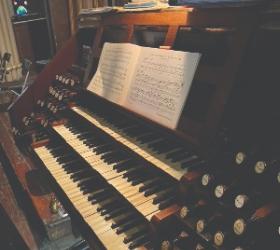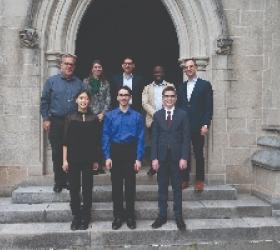
Redman Pipe Organs,
Fort Worth, Texas
St. Vincent’s Cathedral Church, Bedford, Texas
The first organ for St. Vincent’s Episcopal Church in Euless, Texas, was a tracker-action instrument of 18 stops and 23 ranks. It had an entirely mechanical stop action and attached keydesk. I designed the new casework, and we still use it as our logo organ design. The organ was constructed utilizing some recycled windchests and other parts from a Hook & Hastings, originally built for Kavanaugh Methodist Church in Greenville, Texas. The organ had been replaced and broken up for parts. We also utilized some recycled pipes from an 1860 Odell, originally built for Trinity Episcopal Church in New Orleans. Stinkens and Giesecke supplied burnished front pipes of 90% tin and other new pipes. The organ was finished in 1972 and voiced in the neo-baroque manner popular at that time.
While a student at the University of North Texas in Denton, Texas, I had come under the influence of Otto Hofmann of Austin, Texas. Otto had been doing pioneering work in building mechanical-action organs and finished the first permanent installation of this type of instrument in 1956 at Matthews Memorial Presbyterian Church in Albany, Texas.
These were very exciting times in organbuilding, with the rediscovery of tracker-action organbuilding in the USA. After finishing degrees at the University of North Texas and Southern Methodist University, I spent seven years in full-time music ministry. All the while, however, I couldn’t leave organbuilding alone and assisted with several projects, including the first new tracker in the Dallas-Fort Worth area at St. Stephen United Methodist Church in Mesquite, Texas. Finally, the opportunity came to build the organ for St. Vincent’s, and I became a full-time organbuilder.
In 1989, St. Vincent’s built a splendid new church building in nearby Bedford, Texas. We enlarged the organ with new windchests, a vertical extension of the casework, detached three-manual console, and electric stop action. Frank Friemel designed this reconstruction as our Opus 59 with 22 stops and 29 ranks of pipes. Additions included a Salicional and Vox Coelestis in the Swell. A Schalmei replaced the original Krummhorn Regal, and a pedal Mixture replaced the original 2' Flute. The organ was revoiced for the new room, and the sound was broadened and smoothed from the original concept. Further additions were planned and prepared, including a Rückpositiv of eleven stops.
In 1994, the organ was further expanded with new 16' Pedal towers and an entirely new Pedal division. Giesecke provided new 90% burnished tin principal pipes, and we found that the metal matched the pipes from 1971, which had held their appearance very well. Other additions included the 16' Lieblich Gedeckt, 8' Spitzflute, Cornet, and a new and larger 8' Trompete in the Great. The Swell received a new 16' Fagott, and an Oboe replaced the Schalmei. The Pedal now included a 32' Bourdon and a new and larger 16' Posaune.
Finally, in 2007, the organ has been completed according to Frank Friemel’s design as Opus 87, with the new Rückpositiv and a new Festival Trumpet, provided by Schopp. Its intention is to crown the chorus, but not to obliterate it. I believe it does that very well. The other stops of the Rückpositiv provide a more intimate sound than that from the Great and Swell, since it is nearest the ear. Based on a 4' Principal, they provide contrast and fullness as well. The larger and fuller Krummhorn fills that needed stop in the organ. We also used a single 11'3' stop here, instead of a mixture, to provide more registration possibilities along with enough brilliance to the division. The Gemshorn and Celeste are of the classic type, which are flutes with string overtones. They provide a nice contrast to the string celeste in the Swell. Swell shades give additional flexibility to the division.
Many have commented that the organ has “grown up” and matured. This has happened because of the desire of the congregation to have the finest organ possible and to implement the changing esthetics in organ building. It is perhaps a study in how an organ can be enlarged and expanded to meet the demands of a different time and place.
Those who worked on this project include Roy Redman, Frank Friemel, Andrew Packard, Wesley Miller, Joel Grey, Carl Fischer, Joseph Watson, Chris Wilson, and Jake Morris.
—Roy Redman
Redman Pipe Organs
816 East Vickery
Fort Worth, Texas 76104
817/332-2953
[email protected]
A journey and a transformation
When I accepted the position of organist at St. Vincent’s Church in 1984, I was already acquainted with the organ. It was only the third mechanical-action instrument in the Dallas-Fort Worth area, and many organists had made a visit.
Roy Redman had designed and built the instrument, which sat on the floor at the rear of the small church, snuggled against the 17-foot ceiling. This ceiling appeared to be made of pressed string, an inexpensive building material not uncommon in the early ’60s. No matter how many gallons of paint were applied, it still absorbed sound. In this environment, the organ more or less made itself known, but the choir, seated in a corner next to it, had no chance.
In 1985, St. Vincent’s parish committed to build an entirely new campus for the church and school on nearby property in the Fort Worth suburb of Bedford. A tall rectangular building in basilica style was designed by architect Jim Bransford. The choir and organ were to go in a rear gallery with enough height for 16' pedal pipes. A portion of the capital campaign fund was set aside to modify the organ for use in the new building. The then-rector, Father Louis Tobola, was eager for the room to be good for music, and agreed with Roy Redman’s advice to use hard surfaces throughout, and to use double sheetrock, glued together, for the interior walls and ceiling.
The new church was completed in 1989, and the organ was removed from the old property to the Redman shop. A year and a half later, now with a 4' Principal in the Swell and new windchests for the Great and Swell to allow for additional stops, it was re-installed. There had not been enough money in the original campaign to upgrade the Pedal, so it was a bit “top-heavy.”
A second capital campaign raised $60,000 for the Pedal organ. With that amount, we could build the cases and action and have the beautiful tin 16' Principal, but nothing else. Or we could have the cases and all the other Pedal pipes, but no beautiful façade. In a great leap of faith by the vestry, $40,000 was taken from reserves to enable us to fill the Pedal towers in 1994. Now with two 16' manual stops, and a 32' in the Pedal, the transformation of the organ has been amazing.
A transformation of the role of the parish was also begun in 1995, when Bishop Jack L. Iker named St. Vincent’s as the pro-Cathedral of the Diocese of Fort Worth. At the end of 2007, the standing committee of the diocese made our cathedral status permanent.
Though I never gave up hope for the Rückpositiv division, it was many years in coming. At last, in 2007, an anonymous donor contacted Roy and told him to go forward with its design, and to include an en-chamade trumpet on the main case—a stop that many in the choir and congregation had been hoping for. Frank Friemel managed to squeeze ten stops into the Rückpositiv, including swell shades behind the 4' Principal, yet the case is only 38 inches deep; and he made a beautiful arrangement of the horizontal trumpets. The Festival Trumpet stop is commanding, but not overpowering, and, happily, when I play it, it makes people smile.
In its lovely acoustical environment, the organ now possesses great warmth as well as excitement. I feel very fortunate to be on the bench.
—Barbara Burton
Music director and organist
<www.stvc.org>
Cover photo: Dan Hatzenbuehler, Hatzenbuehler Photography (www.hatzphoto.com>
1971
Opus 4
GREAT
8' Principal
8' Rohrgedeckt
4' Octave
4' Holzflote
2' Blockflote
11'3' Mixture IV
8' Trompete
Zimbelstern
SWELL
8' Holzgedeckt
4' Rohrflote
2' Principal
22'3' Sesquialtera II
1' Zimbel III
8' Krummhorn
Tremulant
PEDAL
16' Subbass
8' Principal
4' Choralbass
2' Flute
16' Fagott
1991
Opus 59
GREAT
8' Principal
8' Rohrgedeckt
4' Octave
4' Holzflote
2' Blockflote
11'3' Mixture IV
8' Trompete
Tremulant
Zimbelstern
SWELL
8' Holzgedeckt
8' Salicional
8' Vox Coelestis
4' Principal
4' Rohrflote
2' Spitzflote
22'3' Sesquialtera II
1' Scharf III
8' Schalmei
Tremulant
PEDAL
16' Subbass
8' Principal
4' Choralbass (new)
2' Mixture III
16' Posaune
1994
Opus 66
GREAT
16' Lieblich Gedeckt
8' Principal
8' Rohrgedeckt
8' Spitzflote
4' Octave
4' Holzflote
22'3' Cornet II
2' Octave
11'3' Mixture IV
8' Trompete (new)
Tremulant
Zimbelstern
SWELL
8' Holzgedeckt
8' Salicional
8' Vox Coelestis
4' Principal
4' Rohrflote
2' Spitzflote
22'3' Sesquialtera II
1' Scharf III
16' Fagott
8' Oboe
Tremulant
PEDAL
32' Bourdon
16' Principal
16' Subbass
8' Octave
8' Gedeckt
4' Choralbass
2' Mixture III
16' Posaune (new)
8' Trompete
4' Schalmei
2007
Opus 87
GREAT
16' Lieblich Gedeckt
8' Principal
8' Rohrgedeckt
8' Spitzflote
4' Octave
4' Holzflote
22'3' Cornet II (from G2)
2' Octave
11'3' Mixture IV
8' Trompete
Tremulant
Zimbelstern
SWELL
8' Holzgedeckt
8' Salicional
8' Vox Coelestis
4' Principal
4' Rohrflote
2' Spitzflote
22'3' Sesquialtera II
1' Scharf III (new breaks)
16' Fagott
8' Oboe
Tremulant
PEDAL
32' Bourdon
16' Principal
16' Subbass
8' Octave
8' Gedeckt
4' Choralbass
2' Mixture III
16' Posaune
8' Trompete
4' Schalmei
RÜCKPOSITIV (enclosed)
8' Bordun
8' Gemshorn
8' Gemshorn Celeste (tenor C)
4' Principal (unenclosed)
4' Spillflote
22'3' Nasat
2' Flachflote
13'5' Terz
11'3' Quinte
8' Krummhorn
Tremulant
8' Festival Trumpet (mounted on
central tower)




